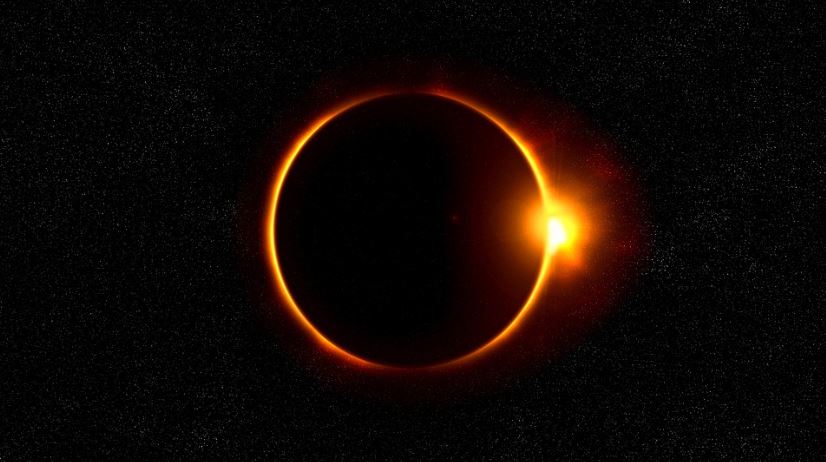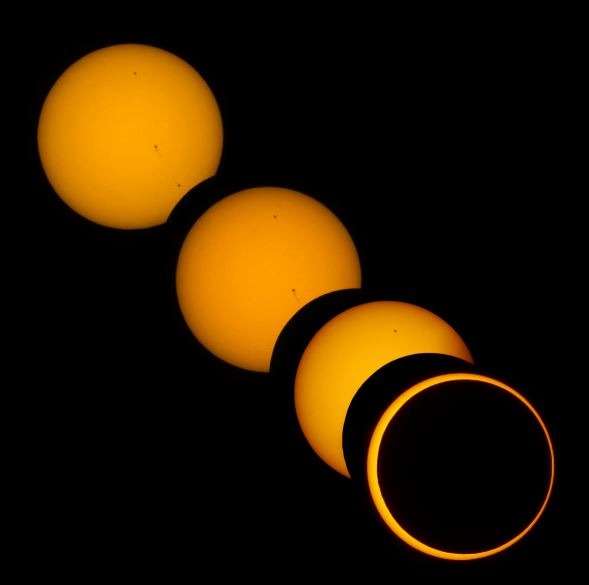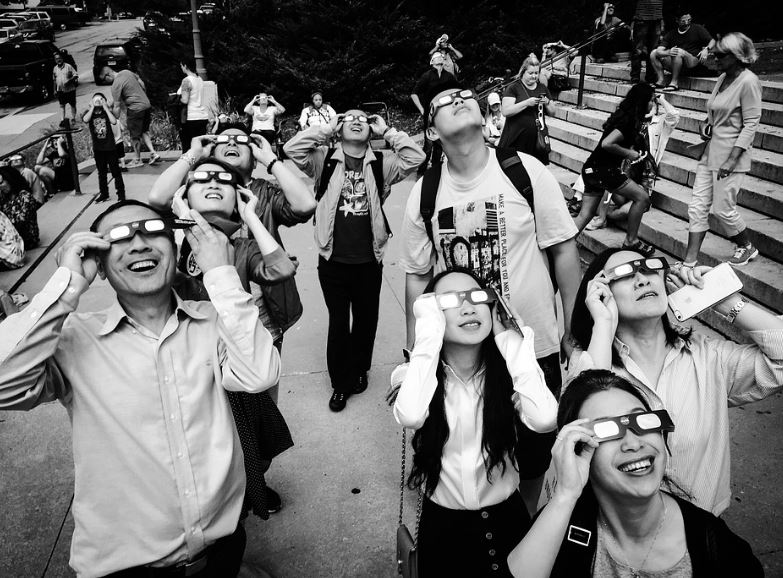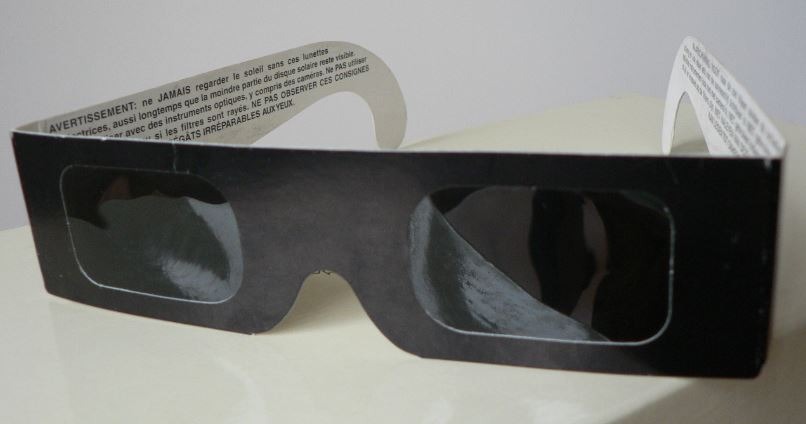A solar eclipse is a breathtaking view and a once-in-a-lifetime astronomical phenomenon. Each of which is only viewable from a specific location. This extraordinary phenomenon happens when the moon passes between the sun and the Earth, casting a shadow on our planet.
A solar eclipse would only occur during the new moon phase when the moon crosses entirely between the Sun and Earth and creates shadows on the planet’s surface. The longest solar eclipse that ever happened lasted for 7 mins and 31 seconds.
Since the moon’s shadow is too small to encompass the whole Earth, it is focused on a specific area. This area varies throughout the eclipse because the Moon and Earth are constantly in motion: the Earth spins around its axis while orbiting the sun, while the moon orbits the Earth. That’s why solar eclipses appear to move from one location to the other.
Types of Solar Eclipse
Solar eclipses are classified into four categories. The magnitude of the eclipse, or how big of the sun’s disk is covered, is determined by where the moon’s shadow lands on Earth.
- Partial solar eclipses happen when the moon only partly conceals the sun’s disk and casts a penumbra on the Earth.
- Annular solar eclipses occur whenever the moon’s disk is still not sufficient to cover the whole sun’s disk, and the sun’s outer layers continue to appear in the skies, forming a ring of fire. Once the moon is at apogee, an annular eclipse of the sun occurs, and the moon’s antumbra is cast upon the Earth.
- Total solar eclipses occur when the moon hides the sun entirely, and they can only happen when the moon is on its perigee, the point in which the moon’s orbit is nearest to the planet. You may only encounter the total solar eclipse if you are in the area in which the moon creates its thickest shadow, known as the umbra.
- The most uncommon kind of solar eclipse is a hybrid solar eclipse, often referred to as annular-total eclipses. They happen when the same eclipse transitions from an annular to a total solar eclipse, or inversely, along its course.
How to Properly View a Solar Eclipse
A total solar eclipse is uncommon — and valuable, much like your eyesight. Once the moon passes in front of the sun, the sky dims, stars glitter, and millions of people are given an opportunity to encounter an astronomical display.
However, aside from the brief total phase or the totality of a total solar eclipse, when the moon completely conceals the sun’s radiant face, which occurs only within the limited area of totality, looking straight at the sun is dangerous. It is dangerous to watch the sun incorrectly during a solar eclipse because of the possibility of eclipse blindness or retinal burns.
Children and young people, according to doctors, are especially in danger because intense light and radiation emitted by the sun can induce overheating and burning of the tissue on the surface of the eye. In elderly persons, the process of aging will help provide a natural filtering function, reducing the chances of retinal injury.
There’s also no point during a partial or annular solar eclipse when it will be fine to look up at the sky without wearing a particularly unique solar filter that meets the international standard ISO 12312-2 transmission specifications.
One appropriate way of watching the uneclipsed, partial, or annular solar eclipse is with special-purpose solar filters, including handheld solar eclipse viewers or solar eclipse glasses. Homemade or usual filters or standard sunglasses, even those that are pretty black, are not suitable to use when gazing at the sun during the eclipse since they emit so much light, even hundreds of times more than the usual light it produces.
You can purchase eclipse glasses at electronic supplies shops, large retail stores, or online shops. Make sure to search for glasses with the ISO 12312-2 certification mark.
Pinhole Projection
Pinhole projection is an alternative approach for safely seeing the partial solar eclipse. Pinhole projection is a much safer option to observe the sun indirectly. For instance, make a waffle shape by crossing both of your hands across one another — partially open fingers of your one hand over the other outstretched hand, slowly opening fingertips of another. Examine the shadow your hands cast on the ground without facing the sun.
The spaces between your fingers will display a pattern of tiny pictures on the ground. When it is in the partial phase of the solar eclipse, the sun’s shadow will look like a crescent moon. When it’s in the annular phase, on the other hand, the shadow will portray a ring shape.
You may also make use of two pieces of cardboard. You first need to cut a hole in one cardboard, then glue a foil covering the hole. And then create a pinhole in the center of the foil. Then use the second piece of cardboard, preferably white for optimal viewing, as a barrier or screen.
Put the cardboard you made as far away from your screen as you can with your back facing the sun. The larger the distance between the pinhole and the screen, the larger the display of the solar eclipse shadow.
Aside from that, you may also use a tree for viewing. Consider looking at photographs of the sun entering through the gaps produced by the leaves. Capture the images using white cardboard to have a great view of the solar eclipse.
Essential Tips When Viewing a Solar Eclipse According to NASA
- Avoid looking directly into the sun.
- Never use handmade filters or regular sunglasses, even if they are pretty dark.
- You may also use special-purpose solar filters, like handheld solar viewers or eclipse glasses, to observe the solar eclipse.
- Read and understand filter directions, and keep an eye on the kids. Before using your solar filter, carefully examine it; if it is dented, pierced, torn, or somehow defective, throw it away. Read thoroughly and follow any directions that come with the solar filter.
- Remember never to peek at the sun using binoculars, camera, telescope, or other optical equipment at any point of the solar eclipse. Remember not to use solar filters with these equipments since concentrated solar radiation can break them and cause severe injuries to the eyes.
A solar eclipse is among nature’s most spectacular displays. By observing these easy precautions, you can admire the view safely and be rewarded with experiences that will last a long time.



